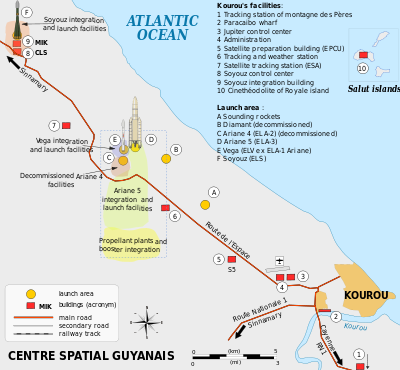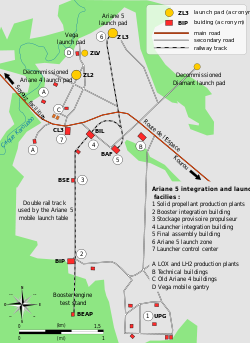Guiana Space Centre

The Guiana Space Centre or, more commonly, Centre Spatial Guyanais (CSG) is a French spaceport near Kourou in French Guiana. Operational since 1968, it is particularly suitable as a location for a spaceport due to its proximity to the equator, and that launches are in a favourable direction over water. The European Space Agency, the French space agency CNES, and the commercial Arianespace company conduct launches from Kourou.
The location was selected in 1964 to become the spaceport of France. When the European Space Agency (ESA) was founded in 1975, France offered to share Kourou with ESA. Commercial launches are bought also by non-European companies. ESA pays two thirds of the spaceport's annual budget, and has also financed the upgrades made during the development of the Ariane launchers.
Contents |
Facilities

Kourou is located approximately 500 kilometres (310 mi) north of the equator, at a latitude of 5°10'. At this latitude, the Earth's rotation gives a velocity of approximately 500 metres per second (1,100 mph; 1,800 km/h) when the launch trajectory heads eastward. The proximity to the equator also makes maneuvering satellites for geosynchronous orbits simpler and less costly.
The ground facilities at Guiana Space Centre (GSC) include launcher (French: l'Ensemble de Lancement) and satellite preparation buildings, launch operation facilities and a solid propellant factory. The GSC facility covers a total of 850 square kilometres (330 sq mi).
ELV (CECLES/ELA-1)
Originally built in the 1960s under the name of CECLES (French: Conférence Européenne de Construction de Lanceurs et d'Engins Spatiaux, English: European conference on construction of launchers and spacecraft), the ELV pad (French: l'Ensemble de Lancement Vega) located at was designed for the Europa-II rocket. One Europa-II was launched from the site, before the programme was cancelled.
The pad was demolished, and subsequently rebuilt as the first launch complex for Ariane rockets. Renamed ELA (later redesignated ELA 1), it was used for Ariane 1 and Ariane 2 and 3 launches until being retired in 1989.[1]
As of 2008, ELV-1 is being rebuilt to support launches of the Vega rocket, back under the current designation of ELV.
ELA 2
The ELA 2 pad (French: l'Ensemble de Lancement Ariane 2), located at had been used for Ariane 4 launches until 2003.
ELA 3
As of 2008, ELA 3 (French: l'Ensemble de Lancement Ariane 3), located at , is currently active for Ariane 5 launches. These facilities cover an area of 21 square kilometres (8.1 sq mi).[2]
ELS / Soyuz at CSG
ESA is currently building ELS (French: l'Ensemble de Lancement Soyouz) for launching Russian-built Soyuz-2 rockets. The first Soyuz launch from ELS has been postponed several times. The current target date for the first launch is December 17, 2010.[3][4][5]
ELS will be located near Sinnamari, a village 10 kilometres (6.2 mi) north of the site used for the Ariane 5 launches. Under the terms of the Russo-European joint venture, ESA will augment its own launch vehicle fleet with Soyuz rockets—using them to launch ESA or commercial payloads—and the Russians will get access to the Kourou spaceport for launching their own payloads with Soyuz rockets. Russia will use the Guiana Space Centre in addition to their Baikonur Cosmodrome, Kazakhstan launching site. The Guiana location has the significant benefit of greatly increased payload capability, owing to the near equatorial position. A Soyuz rocket with a 1.7 tonnes to geostationary transfer orbit (GTO) performance from Baikonur, will increase its payload potential to 2.8 tonnes from the Guiana launch site.[6]
The rocket assembly procedures will differ from ones used at Baikonur. Traditionally, the Soyuz is being fully assembled in horizontal position, then transported to a launch pad and erected for launch. In ELS only the rocket will be assembled in horizontal position, then transported and erected. Then a spacecraft will be transported to the pad separately and attached to the rocket. To protect from dust and wind, the launch pad will have a closed gantry. The gantry will be able to move away from the pad for launch.[7]
The ELS project is being co-funded by Arianespace, ESA, and the European Union, with CNES being the prime contractor. The project has a projected cost of approximately €320 million, where €120 million are allocated for modernizing the Soyuz vehicle [8]. The official opening of the launch site construction occurred on 27 February 2007. Excavation work however, had previously begun several months beforehand. As of May 2008, groundworks were still continuing but the flame pit was substantially complete, along with the shell of the Soyuz assembly building. Equipment manufactured in Russia had arrived in French Guiana by July 2008, with Russian technicians performing the equipment installation at ELS.[3]
In November 2007, reports[9] emerged attributed to Vladimir Grezdilov, general director of the Mir company, of thefts from the Soyuz site near Sinnamari, a village 10 kilometres (6.2 mi) north of the site used for the Ariane-5, that might cause delays to its completion and the first launches. Grezdilov said that the local security company was involved.
In February 2009 ESA reported from Samara, Russia that the launchers destined for the ELS were being built.[10]
On May 21, 2009 Russian news agency ITAR-TASS reported that the first two Soyuz-ST to be launched at ELS have been built, tested and prepared for delivery to ELS.[11]
On August 25, 2009 the general director of the Progress design bureau Alexander Kirilin said that the first launch of the Soyuz-ST from the Kourou space center has been postponed for the beginning of April 2010. He informed that the first three rockets have been built and would be shipped on November 1, 2009 by sea.[5]
Final assembly building
Astrium assembles each Ariane 5 launcher in the Launcher Integration Building. The vehicle is then delivered to the Final Assembly Building for payload integration by Arianespace.[12] The Final Assembly Building is located 2.8 kilometres (1.7 mi) from the ELA-3 launch zone. The mobile launch table completes the trip with an Ariane 5 in about one hour. It is then secured in place over the launch pad's flame ducts.[13]
Launch safety

Fire safety is ensured by a detachment of the Paris Fire Brigade. Safety around the base is ensured by French Gendarmerie forces, assisted by the 3rd Foreign Infantry Regiment of the French Foreign Legion.
Before and during launch windows, CSG facility security is significantly enhanced by anti-personnel and anti-aircraft measures, the exact configurations of which are classified by the French military. All entrants to the launch complex are also subject to checks for proof of permission to enter the facility.
The Guiana Space Centre (as per CNES) also holds the Îles du Salut, a former penal colony including the infamous Devil's Island. Now a tourist site, the islands are under the launching trajectory for geosynchronous orbit and have to be evacuated during launches.
Early launches
- 10 March 1970 - The first Diamant-B launched the DIAL/MIKA and DIAL/WIKA satellites. DIAL/MIKA failed during launch, but entered orbit with a total mass of 111 kg.[14] DIAL/WIKA provided data for about two months after launch.[15]
Recent launches
- 5 October 2007 - An Ariane 5 GS launched from CSG carrying Intelsat 11 and Optus D2.[16]
- 9 March 2008 - An Ariane 5 launched carrying the ATV (Automated Transfer Vehicle) Jules Verne in preparation for docking with the ISS. This was the first launch of the ESA unmanned resupply craft.
- 18 April 2008 - An Ariane 5 launched carrying Vinasat-1 - Vietnam's first satellite.
- 14 August 2008 - An Ariane 5 carrying Superbird 7 for Mitsubishi Electric Corporation and AMC-21 for SES Americom
- 20 December 2008 - An Ariane 5 carrying HOT BIRD 9 AND W2M for Eutelsat[17][18]
- 14 May 2009 - An Ariane 5 carrying the ESA's Herschel and Planck space telescopes[19]
- 1 July 2009 - An Ariane 5 carrying TerreStar-1, the heaviest commercial telecommunications satellite ever launched[20]
References
- ↑ "Pad List - World Launch Sites". Space Launch Report. http://www.geocities.com/launchreport/padsites.html.
- ↑ "Europe's spaceport". ESA. http://www.esa.int/esaCP/GGGMGNF3KCC_Expanding_0.html.
- ↑ 3.0 3.1 "Soyuz launch site hardware arrives in French Guiana". Arianespace. 28 July 2008. http://www.arianespace.com/news-soyuz-vega-2008/2008_07_28_Soyuz-launch-site-hardware-arrives-French-Guiana.asp.
- ↑ "Official opening of the Soyuz launch base construction site in French Guiana". European Space Agency. 26 February 2007. http://www.esa.int/esaCP/SEM0Q3N0LYE_index_0.html.
- ↑ 5.0 5.1 "Soyuz-ST rocket launch from Kourou set for April 2010". http://en.rian.ru/russia/20090825/155922928.html.
- ↑ (French) Le Port Spatial de l'Europe (CNES)
- ↑ Soyuz User's Manual
- ↑ Europe To Pay Russia To Build Soyuz Pad At Kourou: Russia
- ↑ "Thefts Place Russian Rocket Launches Under Threat In French Guiana". RIA Novosti / Spacewar.com. 22 November 2007. http://www.space-travel.com/reports/Site_Thefts_Place_Russian_Rocket_Launches_Under_Threat_In_French_Guiana_999.html. Retrieved 26 November 2007.
- ↑ "Soyuz in Samara (video)". http://mfile.akamai.com/14448/wmv/esa.download.akamai.com/13452/wmv/Soyuz_Samara_POD_02-12-09_wmplow.asx.
- ↑ "Russian rockets readied for South America launch". http://www.spacedaily.com/reports/Russian_rockets_readied_for_South_America_launch_999.html.
- ↑ "Arianespace receives its fifth Ariane 5 of 2008". Arianespace. 28 July 2008. http://www.arianespace.com/site/news/mission-up-524.html.
- ↑ "Ariane 5 rolls out for Arianespace's fifth launch of 2007". Arianespace. November 8, 2007. http://www.arianespace.com/site/news/mission_up_438.html.
- ↑ "DIAL/MIKA - NSSDC ID: 1970-017B". NASA NSSDC. http://nssdc.gsfc.nasa.gov/nmc/spacecraftDisplay.do?id=1970-017B.
- ↑ "DIAL/WIKA - NSSDC ID: 1970-017A". NASA NSSDC. http://nssdc.gsfc.nasa.gov/nmc/spacecraftDisplay.do?id=1970-017A.
- ↑ "Arianespace boosts Intelsat 11 and Optus D2 into orbit". Arianespace. http://www.arianespace.com/site/news/releases/presrel07_10_05.html.
- ↑ http://www.eutelsat.com/satellites/HB9-W2M.html
- ↑ http://www.eutelsat.com/satellites/launch/PR-201208.pdf
- ↑ "ESA en route to the origins of the Universe". ESA. 14 May 2009. http://www.esa.int/esaCP/SEMK2AZVNUF_index_0.html. Retrieved 14 May 2009.
- ↑ "Ariane lofts biggest 'space bird'". BBC. 1 July 2009. http://news.bbc.co.uk/2/hi/science/nature/8129546.stm. Retrieved 2 July 2009.
External links
- Centre Spatial Guyanais official site
- Europe's Spaceport - Information from ESA
- List of Stratospheric Balloons launched from CSG - Information from StratoCat
- Arianespace mission status - Information on current and upcoming Arian missions; list of past missions
|
|||||
|
||||||||||||||||||
|
|||||||||||||||||||||||||||||||||||||||||||||||